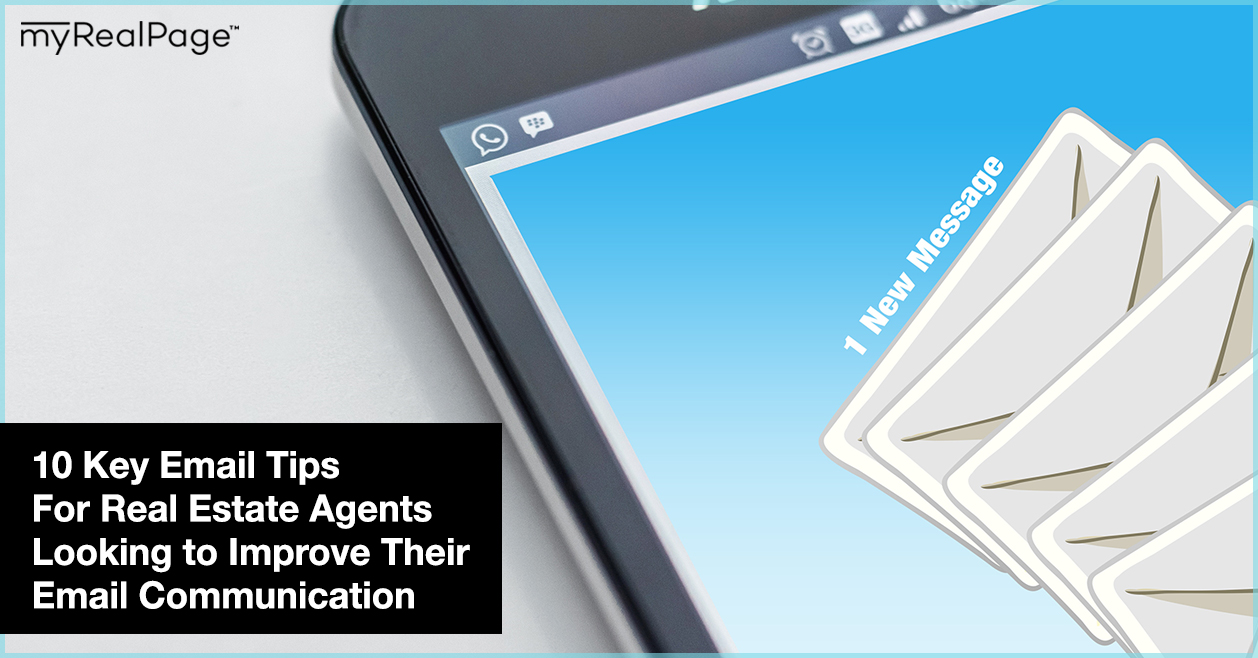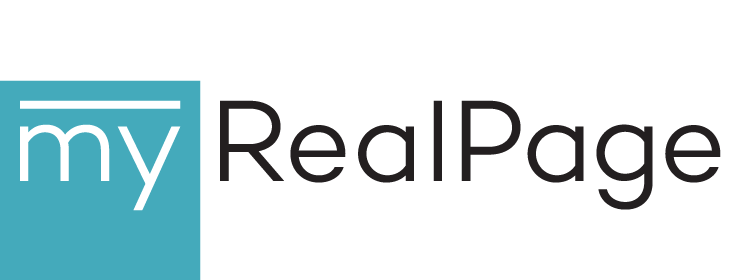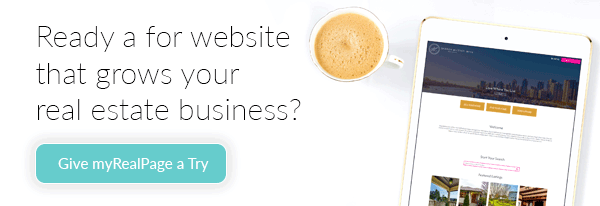10 Key Email Tips For Real Estate Agents Looking to Improve Their Email Communication

Younger REALTORS® may not remember but there was a time, not that long ago, when email wasn’t a key part of the biz.
But that time is hard to remember.
Email is now a fundamental part of any business. In real estate, it’s essential to day-to-day operations, client communications, and marketing to leads.
But like with anything we do every day, a thousand times a day, it’s easy to start resting on our laurels.
After all, it’s just email, right?
Well, not exactly. It’s a tool for strengthening your real estate brand, building and maintaining relationships with clients, and converting leads to customers.
Translation: emails are valuable. And getting them right requires more effort than dictating to Siri as you drive to an open house.
Time for a quick workshop. Read on for 10 key email tips for real estate agents looking to boost their email communication.
1) Think About the Strategy Behind the Send
Not all emails are equal. To maximize your email effectiveness, the very first thing you do should be asking yourself whether your message should be an email at all.
Maybe your message is better suited to a quick phone call. Maybe it’s better off as a text message.
Or maybe it’s a marketing message that should be spread out over three different strategically timed emails — an email marketing practice called a drip campaign.
As communication theorist Marshall McLuhan once said “The medium is the message.” How the message is communicated is as important as the message itself.
2) Use the Right Tools
Like anything else in business, you need to use the right tools for the job. A small selection of carefully chosen apps and platforms can help you take your email game to the next level.
Here are a few of our favourites:
Grammarly
This free Chrome browser extension is like having a built-in proofreader. It catches grammar and spelling errors, flags misused words and makes suggestions for clearer, more powerful writing.
SubjectLine.com
Plug your subject line into this free tool and it will rank it according to variables like deliverability (will it set off spam filters?), length, and suitability for mobile.
This powerful email marketing service is really focused on helping businesses grow through strategic emails that convert leads to clients.
One of the top email marketing tools, thanks to its easy-to-use platform packed with features.
A more affordable email marketing tool, with plenty of bells and whistles for most real estate agents.
3) Get Personal and Personable
Real estate is a personal business. Your clients aren’t just nameless numbers in a computer; they’re real people that you have close interactions with.
Your emails should reflect that. They should be friendly, laidback and reflective of your own voice, tone and real estate brand.
If you’re sending an email to one recipient, be personal and warm. If you’re sending a mass email, find ways to be personable and make recipients feel as though you’re speaking directly to them.
This could mean using email tool features that populate certain fields using information from your subscriber list.
For instance, auto-filling your email greeting with the first name of the recipient, so that instead of a plain “Hi there!”, each recipient sees a personalized hello upon opening your email.
4) Offer Value
You need a good reason to send an email, whether it’s to a colleague, a client or a lead.
For those day-to-day, one-on-one emails, you don’t need to think too hard about value. Your reason for emailing is probably pretty clear.
When it comes to marketing emails to your subscriber list of potential leads, it’s crucial that those emails offer some sort of value. If they don’t, your recipients won’t be keen to open future emails from you.
Before sending an email, think about why your recipient should open it. What’s in it for them? If you can’t identify a reason, then your email lacks value.
Value for a real estate marketing email might be a real estate lead magnet (e.g. a free home consultation, a free guide to prepping your house to list). Or a report on the real estate market in your area. Or a list of exciting new listings that meet your recipient’s needs.
5) Make It Actionable
There’s a desired outcome for every email you send. Think about it.
If you’re emailing your assistant about printing paperwork, you want an acknowledgement that they’re on the job and an estimated completion time.
If you’re emailing a client about new listings, you want to know whether there are any they’d like to see in person.
If you’re emailing a warm lead, you want them to ask for more information or to book a call.
Your email needs to make it clear that a) there’s an action you want your recipient to take and b) how they can take that action.
This means using easy-to-understand language, including a clear call-to-action (e.g. “Can you let me know by end-of-day?” or “Book a 15-minute call with me to talk about prepping your home”) and, if applicable, offering an easy way to take the desired action (e.g. a link to a call-booking platform).
6) Give Your Subject Lines Some Love
Subject lines play a huge role in whether someone opens an email or not. They can be intriguing, but not misleading. Playful, but not ridiculous. Casual, but not aloof.
When writing an email, don’t rush writing the subject line. Play around with a few different options, thinking about whether a subject line effectively:
-
- Suggests what’s inside the email, and
- Compels the recipient to find out what exactly the email has to say.
If you’re using an email marketing tool to send out emails to a group of recipients, take advantage of A/B testing.
This feature lets you create two versions of the same email, but with one element — such as subject line, greeting or call-to-action — tweaked in version B. One segment of your recipients receives version A, the other receives version B. Whichever subject line performs best is the one you’ll use to send the email to the rest of the group.
For subject line inspiration, check out our guides to guaranteed-to-be-opened email subject lines and effective real estate subject lines.
7) Think About Formatting
The contents of your email might be amazing, but if it’s squished together in one big block of text, it doesn’t matter — no one is going to read it.
Formatting is critical to getting results from your emails. How your email is formatted will encourage recipients to read the whole thing (or not).
Strive for short paragraphs of about three sentences. Use bold, italics and underline features sparingly, to emphasize or call out certain parts of your text.
If you’re sending a newsletter, opt for a template with lots of white space and an easy-to-read typeface. If you’re including images, use them sparingly and make sure they don’t overwhelm the text.
8) Work on Your Spelling and Grammar
When your spelling and grammar are perfect (or nearly perfect), no one notices. That’s a good thing.
But when your email copy contains spelling mistakes, irregular capitalization, missing commas and misused words, rest assured your recipient(s) notices. And that matters because those mistakes detract from your message and make you look less professional.
Use a tool like Grammarly to help flag mistakes as you’re writing. Proofread your emails word by word and line by line before you send them. If you’re sending an important email to a big group of people, have a friend or colleague read it over before you send.
9) Time It Right
The time of day at which your email lands in your recipient’s inbox will play a role in how quickly they open it and respond to it. Or whether they open it all.
There are many different schools of thought on the best times to send. To zero in on your ideal time, we suggest:
-
- Reviewing industry research, like this guide by Hubspot;
- Analyzing your past email results to get a sense of when your recipients tend to open emails;
- And, if available, using time optimization features in your email tool of choice. Mailchimp, for example, offers a tool that can make data-based suggestions for ideal deployment times.
10) Experiment
There’s not just one right way of doing things. What works for one agent might not work for another. What worked for you last year might not work for you this year.
The best way to send effective emails: experiment. Change up your strategies, your subject lines, your writing styles. Analyze. Try something new. See what works and what doesn’t. Don’t get stuck in one way of doing things.
What email marketing tool do you use to send emails to large groups of recipients?
Last Updated on June 27, 2024 by myRealPage


